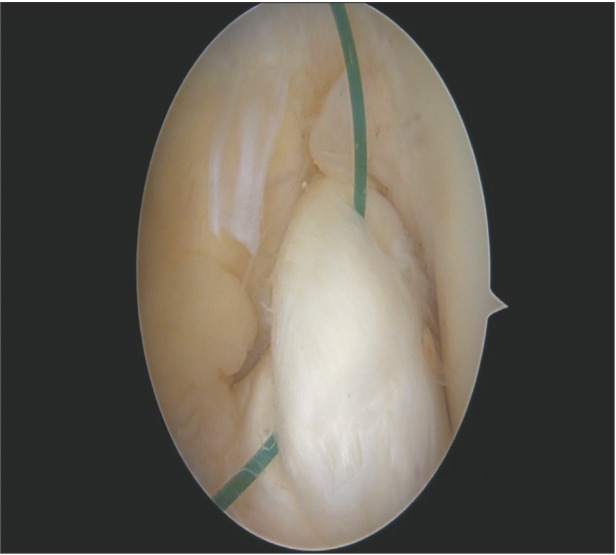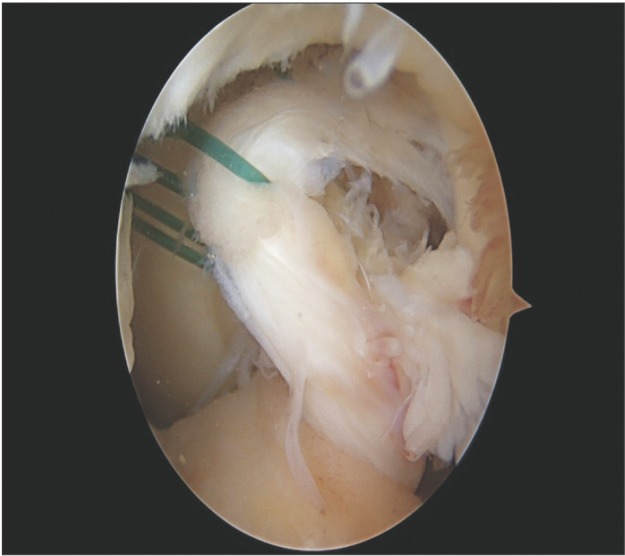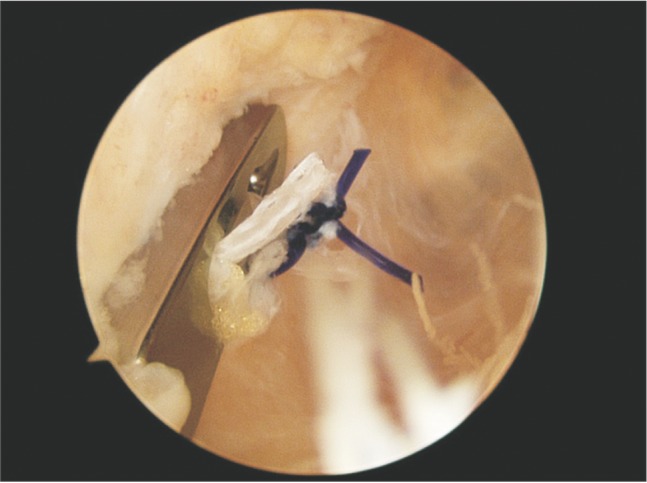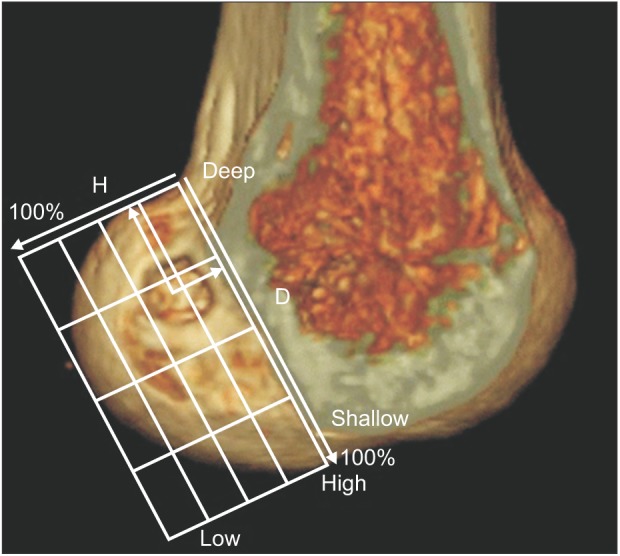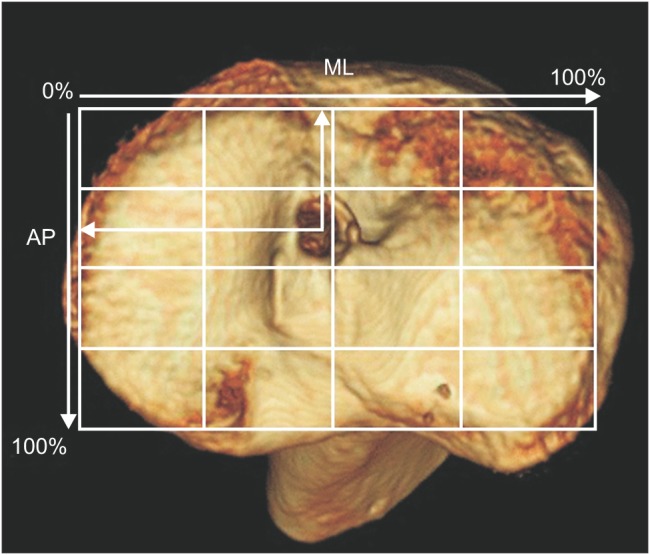Clin Orthop Surg.
2017 Dec;9(4):424-431. 10.4055/cios.2017.9.4.424.
A Comparative Study of Clinical Outcomes and Second-Look Arthroscopic Findings between Remnant-Preserving Tibialis Tendon Allograft and Hamstring Tendon Autograft in Anterior Cruciate Ligament Reconstruction: Matched-Pair Design
- Affiliations
-
- 1Department of Orthopaedic Surgery, Ewha Womans University Mokdong Hospital, Seoul, Korea. koreanknee@gmail.com
- KMID: 2412243
- DOI: http://doi.org/10.4055/cios.2017.9.4.424
Abstract
- BACKGROUND
This study aimed to compare stability, functional outcome, and second-look arthroscopic findings after anterior cruciate ligament reconstruction between remnant-preserving tibialis tendon allograft and remnant-sacrificing hamstring tendon autograft.
METHODS
We matched two groups (remnant-preserving tibialis tendon allograft group and hamstring tendon autograft group) in terms of demographic characteristics, associated injury, and knee characteristics. Each group consisted of 25 patients.
RESULTS
Operation time was longer in the remnant-preserving tibialis tendon allograft group, but there was no significant intergroup difference in stability, clinical outcome, and second-look arthroscopic findings.
CONCLUSIONS
When an autograft is not feasible in anterior cruciate ligament reconstruction, the remnant-preserving technique can produce comparable results in terms of restoration of function, stability of the knee, and degree of synovium coverage at second-look arthroscopy compared to remnant-sacrificing hamstring autograft.
Keyword
MeSH Terms
-
Adolescent
Adult
Allografts
Anterior Cruciate Ligament Injuries/complications/*surgery
Anterior Cruciate Ligament Reconstruction/adverse effects/*methods
Arthroscopy
Autografts
Female
Humans
Imaging, Three-Dimensional
Joint Instability/diagnostic imaging/*etiology
Knee Joint/diagnostic imaging/physiopathology/*surgery
Lysholm Knee Score
Male
Matched-Pair Analysis
Middle Aged
Operative Time
Retrospective Studies
Second-Look Surgery
Tendons/*transplantation
Tomography, X-Ray Computed
Treatment Outcome
Young Adult
Figure
Reference
-
1. Cvetanovich GL, Mascarenhas R, Saccomanno MF, et al. Hamstring autograft versus soft-tissue allograft in anterior cruciate ligament reconstruction: a systematic review and meta-analysis of randomized controlled trials. Arthroscopy. 2014; 30(12):1616–1624. PMID: 25108904.
Article2. Biau DJ, Tournoux C, Katsahian S, Schranz PJ, Nizard RS. Bone-patellar tendon-bone autografts versus hamstring autografts for reconstruction of anterior cruciate ligament: meta-analysis. BMJ. 2006; 332(7548):995–1001. PMID: 16603564.
Article3. Yoo SH, Song EK, Shin YR, Kim SK, Seon JK. Comparison of clinical outcomes and second-look arthroscopic findings after ACL reconstruction using a hamstring autograft or a tibialis allograft. Knee Surg Sports Traumatol Arthrosc. 2017; 25(4):1290–1297. PMID: 26718638.
Article4. Mardani-Kivi M, Karimi-Mobarakeh M, Keyhani S, Saheb-Ekhtiari K, Hashemi-Motlagh K, Sarvi A. Hamstring tendon autograft versus fresh-frozen tibialis posterior allograft in primary arthroscopic anterior cruciate ligament reconstruction: a retrospective cohort study with three to six years follow-up. Int Orthop. 2016; 40(9):1905–1911. PMID: 26987981.5. Carey JL, Dunn WR, Dahm DL, Zeger SL, Spindler KP. A systematic review of anterior cruciate ligament reconstruction with autograft compared with allograft. J Bone Joint Surg Am. 2009; 91(9):2242–2250. PMID: 19724004.
Article6. Leo BM, Krill M, Barksdale L, Alvarez-Pinzon AM. Failure rate and clinical outcomes of anterior cruciate ligament reconstruction using autograft hamstring versus a hybrid graft. Arthroscopy. 2016; 32(11):2357–2363. PMID: 27286700.
Article7. Ahn JH, Wang JH, Lee YS, Kim JG, Kang JH, Koh KH. Anterior cruciate ligament reconstruction using remnant preservation and a femoral tensioning technique: clinical and magnetic resonance imaging results. Arthroscopy. 2011; 27(8):1079–1089. PMID: 21704468.
Article8. Ko YW, Rhee SJ, Kim IW, Yoo JD. The correlation of tunnel position, orientation and tunnel enlargement in outside-in single-bundle anterior cruciate ligament reconstruction. Knee Surg Relat Res. 2015; 27(4):247–254. PMID: 26672479.
Article9. Bernard M, Hertel P, Hornung H, Cierpinski T. Femoral insertion of the ACL: radiographic quadrant method. Am J Knee Surg. 1997; 10(1):14–21. PMID: 9051173.10. Tsuda E, Ishibashi Y, Fukuda A, Yamamoto Y, Tsukada H, Ono S. Tunnel position and relationship to postoperative knee laxity after double-bundle anterior cruciate ligament reconstruction with a transtibial technique. Am J Sports Med. 2010; 38(4):698–706. PMID: 20139333.
Article11. Barrett G, Stokes D, White M. Anterior cruciate ligament reconstruction in patients older than 40 years: allograft versus autograft patellar tendon. Am J Sports Med. 2005; 33(10):1505–1512. PMID: 16009990.12. Li H, Tao H, Cho S, Chen S, Yao Z, Chen S. Difference in graft maturity of the reconstructed anterior cruciate ligament 2 years postoperatively: a comparison between auto-grafts and allografts in young men using clinical and 3.0-T magnetic resonance imaging evaluation. Am J Sports Med. 2012; 40(7):1519–1526. PMID: 22495290.13. Mascarenhas R, Erickson BJ, Sayegh ET, et al. Is there a higher failure rate of allografts compared with autografts in anterior cruciate ligament reconstruction: a systematic review of overlapping meta-analyses. Arthroscopy. 2015; 31(2):364–372. PMID: 25220350.14. Sun K, Zhang J, Wang Y, et al. Arthroscopic reconstruction of the anterior cruciate ligament with hamstring tendon autograft and fresh-frozen allograft: a prospective, randomized controlled study. Am J Sports Med. 2011; 39(7):1430–1438. PMID: 21441418.
- Full Text Links
- Actions
-
Cited
- CITED
-
- Close
- Share
- Similar articles
-
- Comparison of the Outcomes on Second-Look Arthroscopy after Anterior Cruciate Ligament Reconstruction Using a Hamstring Autograft or a Tibialis Anterior Allograft
- Arthroscopic Revision Anterior Cruciate Ligament Reconstruction: Report of 5 Cases
- Comparison of Clinical Results in Anterior Cruciate Ligament Reconstruction Using Bone-Patellar Tendon-Bone Autograft and Using Achilles Tendon Allograft
- Changes in hamstring strength after anterior cruciate ligament reconstruction with hamstring autograft and posterior cruciate ligament reconstruction with tibialis allograft
- Clinical Outcomes after Arthroscopic ACL Reconstruction using Bone-Patellar Tendon-Bone Allografts, Anterior Tibialis Tendon Allografts, and Hamstring Tendon Autografts

